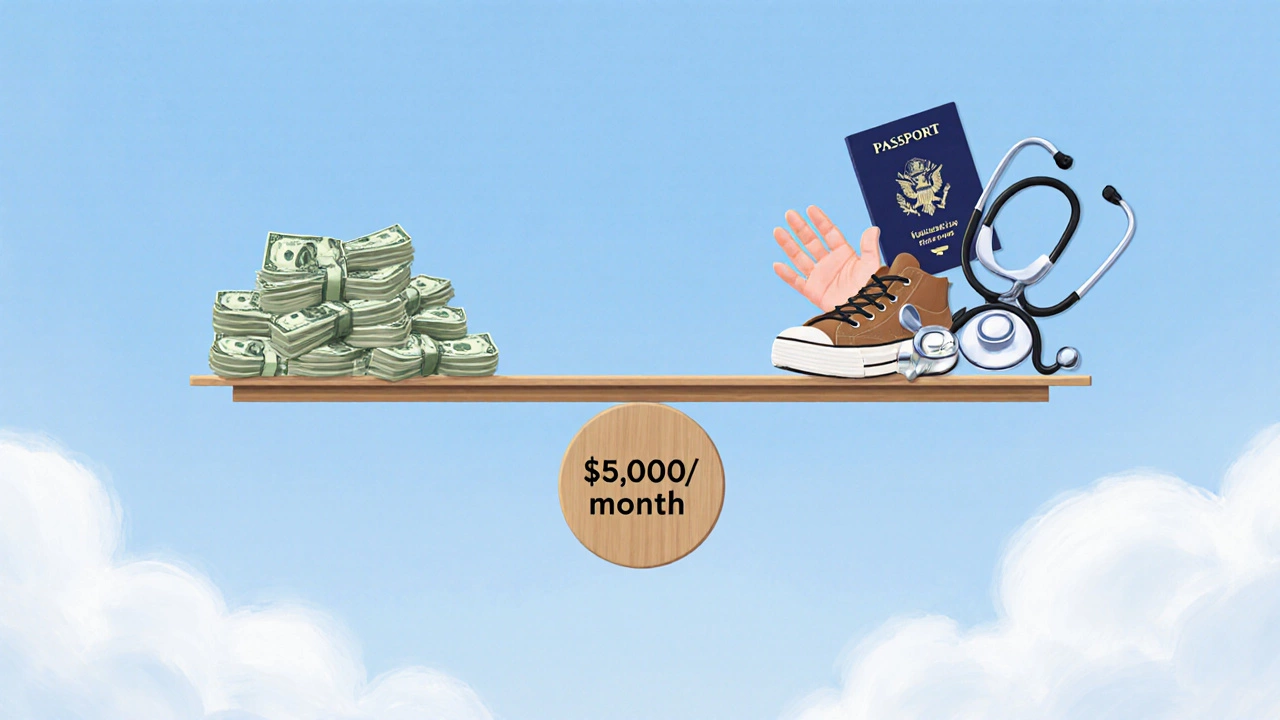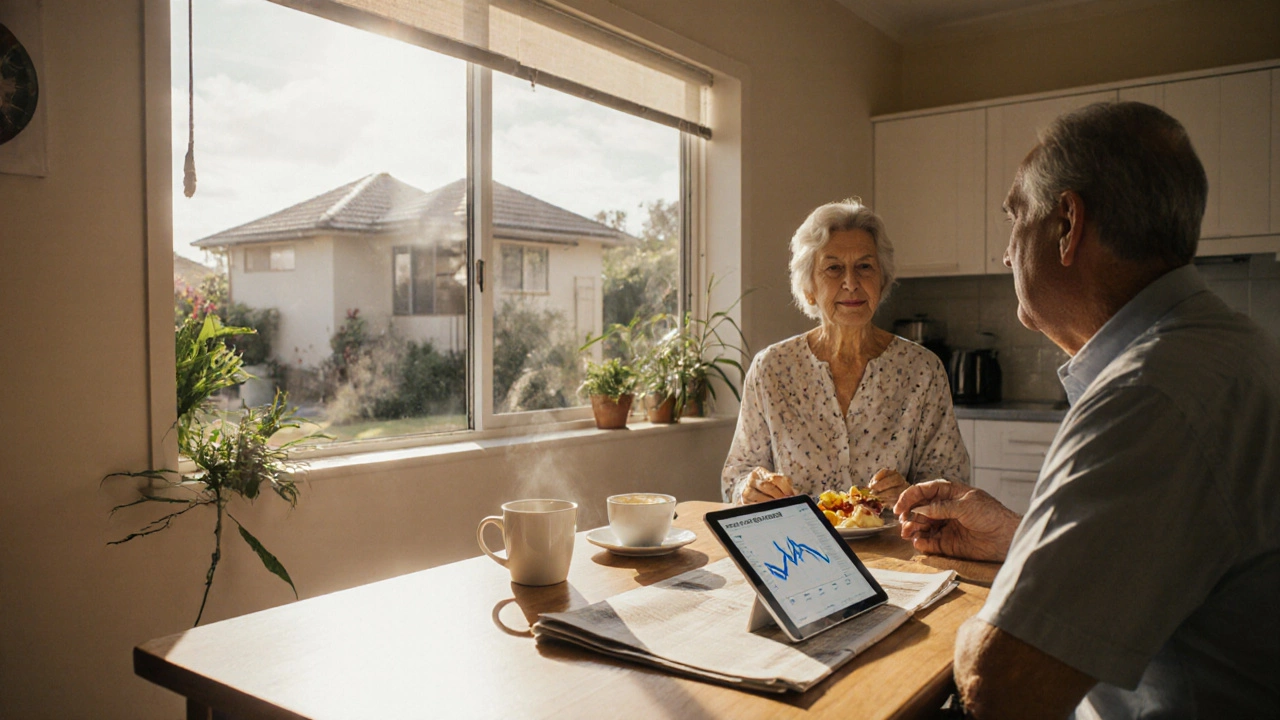Australia Retirement Budget Calculator
See how your retirement expenses stack up against the $6,000 monthly benchmark in Australia. Adjust your costs and see if you're on track for comfortable retirement.
Your Retirement Expenses
Results
$6,000 monthly retirement income benchmark
Important: Inflation can reduce your purchasing power. With 3.5% annual inflation, your $6,000 will only have the buying power of $4,200 in 10 years.
Is $6,000 a month a good pension? If you’re asking that question, you’re probably closer to retirement than you think - and you’re not alone. Many Australians are staring down their retirement years wondering if their savings will actually cover what they need. The short answer? For most people in Australia, $6,000 a month is more than enough. But whether it’s good depends on where you live, how you live, and what you expect from your later years.
What Does $6,000 a Month Really Buy You in Australia?
Let’s break it down. $6,000 a month is $72,000 a year before tax. After tax, you’re looking at roughly $60,000-$64,000 net, depending on your age and whether you’re receiving the Age Pension too. That’s well above the average Australian retirement income. According to the Australian Bureau of Statistics, the median household income for retirees is around $45,000 a year. So $6,000 a month puts you in the top 25% of retirees.
Here’s what that kind of income can cover in a typical Australian city like Sydney or Melbourne:
- Housing: Mortgage-free home? Great. Renting a two-bedroom apartment? That’ll cost $2,800-$3,500 a month in Sydney. With $6,000, you can afford this and still have room to breathe.
- Utilities and internet: Around $300-$400 a month, including electricity, gas, water, and mobile plans.
- Food and groceries: $800-$1,000 a month for two people eating well, not extravagantly.
- Healthcare: Medicare covers most basics. Private health insurance? Around $200-$300 a month. Medications? Most are subsidized under the PBS.
- Transport: One car, paid off, with fuel and registration? $400-$500. Public transport? Less than $150.
- Entertainment, travel, hobbies: $500-$1,000. That’s two weekend getaways a year, a monthly movie night, or a weekly coffee with friends.
That’s $5,000-$5,700 covered. You’ve got $300-$1,000 left over. That’s not just spare change - that’s freedom. You can afford a new pair of glasses, a dental check-up, a trip to visit family in Queensland, or a new garden without stressing.
Who Might Find $6,000 a Month Not Enough?
It’s not all sunshine. Some people still struggle - even with $6,000 a month. Here’s who:
- People with major health issues: If you need regular specialist visits, private hospital cover, or ongoing physiotherapy, costs can balloon. A single hip replacement can cost $15,000 out-of-pocket without insurance. Chronic conditions like diabetes or heart disease add up fast.
- Those supporting adult children: Some retirees are still helping their kids with rent, university fees, or medical bills. That $6,000 gets stretched thin fast when you’re covering two households.
- People who bought into lifestyle inflation: If you’re used to private school fees, overseas holidays, or luxury cars, $6,000 might feel tight. Retiring doesn’t mean downgrading - but it does mean redefining what ‘enough’ looks like.
- Those who didn’t plan for inflation: $6,000 today isn’t $6,000 in 10 years. If your pension doesn’t grow with inflation, your buying power shrinks. CPI in Australia has averaged 3.5% over the last decade. That means your $6,000 will need to be $8,400 in 10 years just to keep up.
How Does $6,000 Compare to the Age Pension?
The Australian Age Pension is $1,043.60 per fortnight for a single person (as of July 2025). That’s $2,187 a month. If you’re receiving the full Age Pension, you’re living on less than half of $6,000.
That’s why many retirees combine the Age Pension with their superannuation. If you have $6,000 a month coming in, you’re likely drawing from super, investments, or a combination. You’re not relying on government support - you’ve built your own safety net.
Here’s the kicker: To get the full Age Pension, your assets must be under $307,500 (for a single homeowner). If you have $1 million in super, you get zero Age Pension. So $6,000 a month means you’ve done the work. You’ve saved. You’ve planned. You’re not waiting for the government to bail you out.

What’s the Real Goal? Comfort, Not Just Survival
Retirement isn’t about surviving. It’s about living. And $6,000 a month gives you real choice.
Imagine this: You wake up on a Tuesday morning. You’ve got your coffee. You’ve got your Medicare card. Your car’s paid off. You’re not worrying about whether you can afford to see your grandchild’s school play. You’re not skipping meals to pay the power bill. You’re not turning down a trip to Bali because it’s ‘too expensive’.
That’s not luxury. That’s dignity.
Most retirees who struggle aren’t short on money - they’re short on control. They’re stuck in rental housing. They’re paying high fees to financial advisors who don’t understand their needs. They’re using credit cards to cover basics. $6,000 a month gives you the power to say no to stress.
How to Make Sure $6,000 Lasts
Having $6,000 a month is great. But if you blow through your savings in five years, it doesn’t matter. Here’s how to make it last:
- Withdraw wisely: Don’t just take out $6,000 every month. Use the 4% rule as a guide - withdraw 4% of your total retirement savings per year, adjusted for inflation. If you have $1.8 million in super, $6,000/month is 4% - perfect.
- Keep some cash reserves: Have 6-12 months of expenses in a high-interest savings account. That covers emergencies without touching your investments.
- Review your insurance: Do you still need income protection? Probably not. But do you need total and permanent disability cover? Maybe. Review every two years.
- Downsize if needed: If your home is too big, consider selling and moving to a smaller place. That frees up cash and cuts maintenance costs.
- Use the Pension Loans Scheme: If you own your home but need extra cash, the government lets you borrow against your home equity. It’s not a loan you repay until you sell or die - and it doesn’t affect your Age Pension eligibility.

What If You’re Not There Yet?
If $6,000 a month feels out of reach, don’t panic. You’re not too late. Here’s what you can do now:
- Boost your super: Even $200 extra a month from age 50 can add $100,000+ by 67. Use salary sacrifice or after-tax contributions.
- Delay retirement by 2-3 years: Every extra year working adds to your super and delays withdrawals. That’s two years of compounding growth and two fewer years of spending.
- Downsize your home: Selling a large family home in Sydney and moving to a unit or regional area can easily net you $500,000+ extra.
- Work part-time: Even $1,000 a month from a weekend job or consulting gig adds up - and keeps you socially engaged.
You don’t need to be rich. You just need to be intentional.
Final Thought: It’s Not About the Number - It’s About the Peace
$6,000 a month isn’t magic. It’s not the answer for everyone. But for most Australians, it’s the threshold between stress and security. It’s the line between wondering if you can afford the next doctor’s visit - and knowing you can.
Retirement isn’t about having the most. It’s about having enough. And if you’re getting $6,000 a month, you’ve already crossed that line.
Is $6,000 a month enough to retire on in Australia?
Yes, $6,000 a month is more than enough for most retirees in Australia. It’s well above the median retirement income of $45,000 a year. After covering housing, food, healthcare, and basic living costs, you’ll still have room for travel, hobbies, and emergencies - assuming you manage your spending and plan for inflation.
How much super do I need to get $6,000 a month?
To safely withdraw $6,000 a month ($72,000 a year), you’ll need around $1.8 million in superannuation, assuming you follow the 4% rule. This rule suggests withdrawing 4% of your total savings annually, adjusted for inflation, to make your money last 30+ years. If you’re also receiving the Age Pension, you may need less in super.
Can I get the Age Pension if I have $6,000 a month from super?
No. If you’re receiving $6,000 a month from super or investments, you likely have too many assets to qualify for the full Age Pension. The asset test cuts off full payments for single homeowners with over $307,500 in assets. However, you may still qualify for a part-pension if your total income and assets fall within the limits.
What happens to $6,000 a month after 10 years with inflation?
With inflation averaging 3.5% a year, $6,000 today will have the buying power of about $4,200 in 10 years. To keep up, your retirement income needs to increase annually. If your super is invested in growth assets and you withdraw a fixed percentage (like 4%), your payments will naturally rise with market returns - helping offset inflation.
Should I downsize my home to boost my pension?
Yes, downsizing can be one of the smartest moves for retirement. Selling a large family home in Sydney and moving to a smaller property or regional area can free up $300,000-$800,000. You can put that into super (up to the contribution caps), invest it, or keep it as a cash buffer - all of which boost your retirement security.
Is $6,000 a month enough if I have chronic health issues?
It can be - but you’ll need to plan ahead. Chronic conditions often mean higher out-of-pocket costs for specialists, medications, and home care. Private health insurance helps, but it’s not a cure-all. Set aside a dedicated health fund within your budget, and consider the Commonwealth Seniors Health Card, which gives discounts on prescriptions and other services.
What’s the biggest mistake people make with $6,000 a month in retirement?
The biggest mistake is treating it like a paycheck and spending it all without a plan. Many retirees don’t adjust for inflation, forget to factor in future medical costs, or give away large sums to family members. The key is to treat your retirement savings like a long-term investment - not a bonus account.
